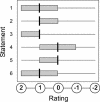Evaluation of two CD-ROMs from a series on cell biology
- PMID: 14673491
- PMCID: PMC256973
- DOI: 10.1187/cbe.03-01-0002
Evaluation of two CD-ROMs from a series on cell biology
Abstract
Two CD-ROMs from a series dealing with various major aspects of cell biology are evaluated in this paper using quantitative and qualitative approaches. The findings delimit similarities and differences of the two CD-ROMs and shed light on how the programs could be used in the learning process and how they should not be. The overall impression, as well as the graphical and technical features, received a predominantly good rating. The defined target groups were reached (e.g., students in secondary schools), different learning approaches were supported (e.g., discovery and autonomous learning), the CD-ROMs' usability was assessed as being easy and intuitive, and the majority of the evaluators were satisfied with the level of interactivity. Navigational problems encountered in CD-ROM 1 were overcome by a successful implementation of new navigational functions in CD-ROM 2. Most students found the CD-ROM to be a suitable complement to, or an extension of, their lessons. We conclude that many, but not all of the requirements for the various stages of the learning process could be satisfied with the existing CD-ROMs. The requirements not met are discussed to obtain insights that could help to improve the production of multimedia learning material. The use of quantitative and qualitative approaches in the evaluation of learning modules is discussed, as the study began by collecting and analyzing anecdotal reviews and was then extended to include a qualitative evaluation.
Figures








References
-
- Baumgartner P. Didaktische Anforderungen an (multimediale) Lernsoftware. In: Issing L. J., Klimsa P., editors. Information und Lernen mit Multimedia. 2nd ed. Psychologie-Verl.-Union; Weinheim: 1997. pp. 241–252.
-
- Baumgartner P. Evaluation mediengestützen Lernens. Theorie-Logik-Modelle. In: Kindt M., editor. Projektevaluation in der Lehre Multimedia an Hochschulen zeigt Profil(e) Waxmann; Münster: 1999. pp. 62–99.
-
- Baumgartner P. Bildung B., editor. Webbasierte Lernumgebungen—neue Ansätze zum Politiklernen. “Traditionelle und Neue Medien im Politikunterricht” der Schriftenreihe der Bundeszentrale für politische Bildung. 2001.
-
- Bereiter-Hahn J., Peters W. The Cell I—Life from Light and Air [CD-ROM] IWF; Göttingen: 1999.
-
- Bereiter-Hahn J., Peters W. The Cell II—The Powerplant—Mitochondrion and Catabolic Metabolism [CD-ROM] IWF; Göttingen: 2001.
Publication types
MeSH terms
LinkOut - more resources
Full Text Sources
Miscellaneous
